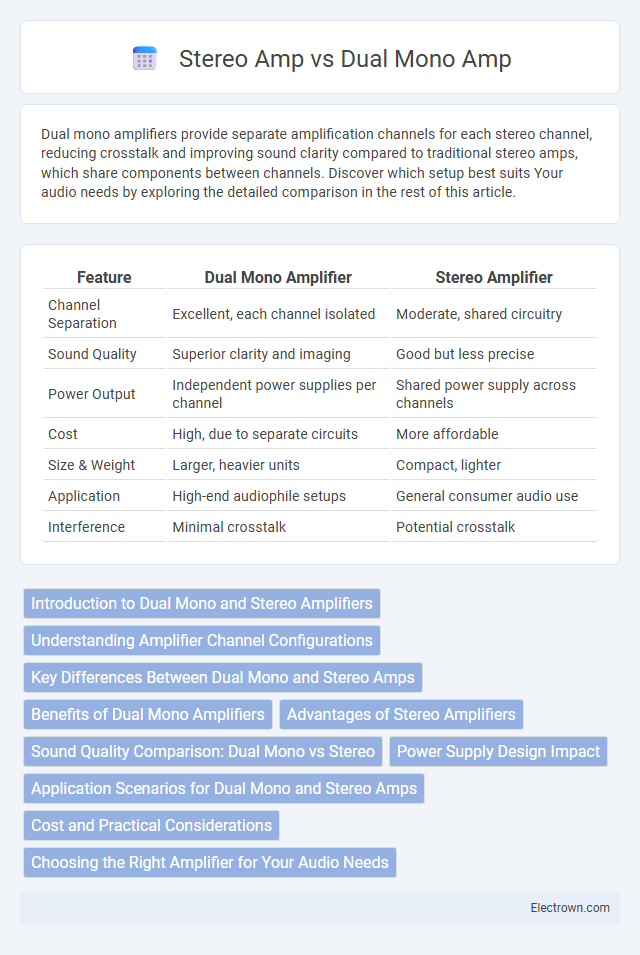Dual mono amplifiers provide separate amplification channels for each stereo channel, reducing crosstalk and improving sound clarity compared to traditional stereo amps, which share components between channels. Discover which setup best suits Your audio needs by exploring the detailed comparison in the rest of this article.
Table of Comparison
| Feature | Dual Mono Amplifier | Stereo Amplifier |
|---|---|---|
| Channel Separation | Excellent, each channel isolated | Moderate, shared circuitry |
| Sound Quality | Superior clarity and imaging | Good but less precise |
| Power Output | Independent power supplies per channel | Shared power supply across channels |
| Cost | High, due to separate circuits | More affordable |
| Size & Weight | Larger, heavier units | Compact, lighter |
| Application | High-end audiophile setups | General consumer audio use |
| Interference | Minimal crosstalk | Potential crosstalk |
Introduction to Dual Mono and Stereo Amplifiers
Dual mono amplifiers feature two completely independent amplifier circuits for left and right channels, enhancing channel separation and minimizing crosstalk. Stereo amplifiers use a shared power supply and common circuitry, which can introduce slight interference between channels. Audiophiles often prefer dual mono designs for superior sound clarity and precision in high-fidelity audio systems.
Understanding Amplifier Channel Configurations
Dual mono amplifier configurations feature separate power supplies and circuitry for each channel, minimizing crosstalk and enhancing channel separation for improved sound clarity. Stereo amplifiers share components between channels, which can increase interference but reduce overall cost and size. Your choice depends on whether you prioritize maximum audio fidelity or practical convenience in your audio setup.
Key Differences Between Dual Mono and Stereo Amps
Dual mono amplifiers feature completely separate amplification circuits for each channel, minimizing crosstalk and enhancing channel separation for superior audio clarity. Stereo amplifiers share a common power supply and chassis, which can lead to minor interference but offer a more compact design and cost efficiency. The isolated architecture of dual mono amps delivers improved power stability and dynamic range, making them ideal for audiophiles seeking precise soundstage and imaging.
Benefits of Dual Mono Amplifiers
Dual mono amplifiers offer superior channel separation by utilizing independent power supplies and circuits for each channel, reducing crosstalk and distortion. This design enhances soundstage clarity and imaging, providing a more immersive and precise listening experience. Audiophiles benefit from improved dynamic range and lower noise floor, resulting in cleaner and more detailed audio reproduction compared to traditional stereo amps.
Advantages of Stereo Amplifiers
Stereo amplifiers offer a cohesive and natural soundstage by delivering two independent audio channels through a single integrated unit, enhancing the spatial accuracy of your music. They provide convenience and space-saving benefits without compromising audio quality, making them ideal for home audio systems. Your listening experience benefits from the seamless synchronization between channels, which often results in clearer and more balanced sound reproduction compared to dual mono setups.
Sound Quality Comparison: Dual Mono vs Stereo
Dual mono amplifiers offer superior sound quality by providing completely separate left and right channels, which minimizes crosstalk and enhances channel separation for a more precise stereo image. Stereo amplifiers, while convenient and cost-effective, often share power supplies or circuitry between channels, potentially introducing interference and reducing overall clarity. Audiophiles typically prefer dual mono setups for their improved dynamic range, reduced distortion, and more accurate soundstage reproduction.
Power Supply Design Impact
Dual mono amplifiers feature independent power supplies for each channel, significantly reducing crosstalk and enhancing channel separation compared to stereo amps that share a single power supply. This dedicated design improves overall sound clarity and dynamic range by minimizing electrical interference and voltage fluctuations between channels. Your listening experience benefits from a more precise and immersive audio reproduction due to the superior power supply isolation found in dual mono configurations.
Application Scenarios for Dual Mono and Stereo Amps
Dual mono amplifiers excel in high-fidelity audio setups where channel separation and minimal crosstalk are critical, such as audiophile home theaters or professional studio monitoring. Stereo amps are ideal for general consumer use, offering a compact and cost-effective solution for typical two-channel listening environments like living rooms or casual music playback. Your choice depends on whether you prioritize sonic precision and isolation or convenience and space-saving design.
Cost and Practical Considerations
Dual mono amplifiers typically cost more than stereo amps due to separate power supplies and chassis for each channel, increasing manufacturing complexity and component count. Your choice might depend on available space and budget, as dual mono units require more physical room and often higher investment upfront. Practical considerations include improved channel separation and reduced crosstalk with dual mono, but stereo amps offer a more compact and generally more affordable solution for everyday listening setups.
Choosing the Right Amplifier for Your Audio Needs
Dual mono amplifiers separate the left and right channels into two independent units, reducing crosstalk and enhancing stereo imaging for superior sound clarity. Stereo amplifiers combine both channels in a single chassis, offering convenience and space efficiency without significant sacrifice in audio quality for most listeners. Your choice depends on the priority you place on audio fidelity versus setup simplicity and budget constraints.
dual mono vs stereo amp Infographic

 electrown.com
electrown.com